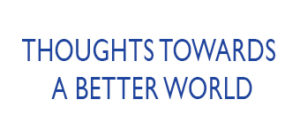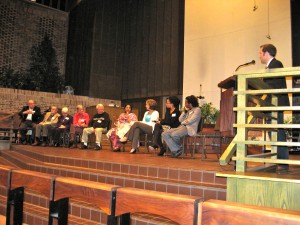#272 – Dick Bernard: War, and Peace
A few days ago we finished the biennial reenactment of the Civil War – the 2010 elections. While this is a supposedly bloodless sport, the biennial result is “a house divided” where one side “wins” and the other “loses”. The aim, especially strong today, is to kill the opposing point of view, relevant though it may be.
The instant this political Civil War ended, the next one began. It’s a wonder our country survives. One wonders what our community, national and global landscape would look like if we didn’t insist on dissipating our energy and resources to fight constantly against each other, and, rather, try to work towards agreement on things.
Oh, it’s a dream.
In the election just past, one candidate for a Minnesota Congressional seat defeated the 35-year incumbent U.S. Representative who had a great record of representing the interests of the district. The challenger had no previous experience in government outside of military service. He was described as applying “a military theme to his campaign. His battered motor home was called the “war wagon”. Campaign staffers and volunteers were given military titles – commanders, captains lieutenants.” (Minneapolis Star Tribune, page A12, November 4, 2010). The district loses a representative with great seniority who effectively represented its interests. It gets a new representative with no seniority or experience who campaigned against the very things which led to his opponents many re-elections. The elder statesman was a casualty of a ‘throw ’em out’ mentality.
Destructive as it is to us, we love war, especially as a spectator sport.
(In 1860 the U.S. population was about 31 million, one-tenth of today’s. There were over 365,000 Civil War deaths in 1861-65, and 282,000 more wounded. In today’s political combat, there are no rotting corpses on assorted political battlefields, but there is residual and permanent damage to our effectiveness as a nation. The political goal is to render impotent the opposition. Back and forth we go….)
It was very good for me and many others to be able to shift gear at the end of election week, to move away from combat for awhile.
Friday night I attended a collaborative event of the Hawkinson Foundation and the Minnesota Alliance of Peacemakers, “Building Generations Together: Creating a Culture of Peace“.
This was a tremendously inspiring event.
During the Awards section of the program, several younger people from many cultures received awards for their grassroots work on building community through working together. (Their bios and accomplishments are outlined at the aforementioned Hawkinson Foundation website).
At the end of the evening, the award winners joined in a dialogue with five elders (their profiles also at the website) in the Twin Cities Peace and Justice Community, to give their views on a number of different questions. The elders were Carol and Ken Masters, Rev Verlyn Smith, Rev. James Siefkes and Mary Lou Nelson. It was greatly refreshing to see the elders and youngers dialoguing together, while those of us in the audience, primarily elders, listened and learned.
Everyone listened respectfully to the presentations and the dialogue.
I can only speak for myself: I left the evening tired but energized, with a couple of new insights, which for me made the time expended completely worthwhile.
In a few days we commemorate Armistice Day, November 11, the day “the war to end all wars”, WWI, ended in 1918.
Of course, the end of WWI didn’t end war; it just ensured a subsequent and even more awful war. That is the normal consequence of combat as a resolution to differences.
Peace may not be quite as fun as contemporary political combat, but it is certainly more productive.
Give Peace a chance.
Related post here.

